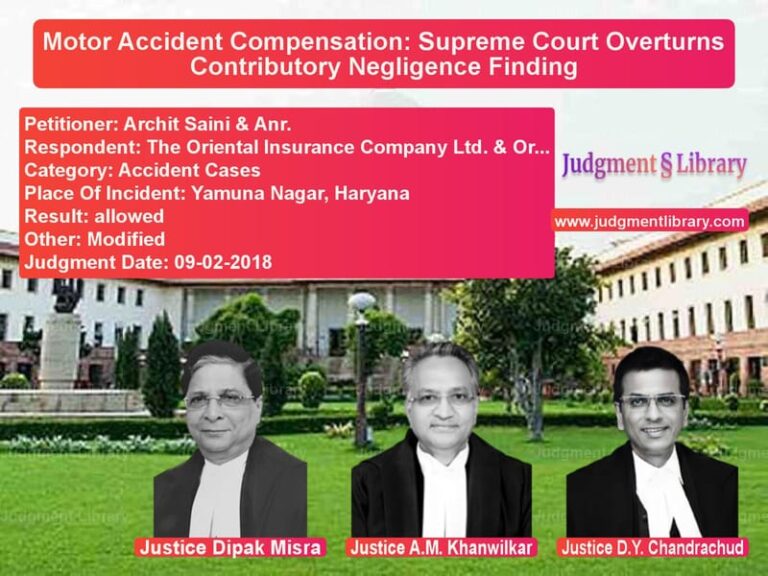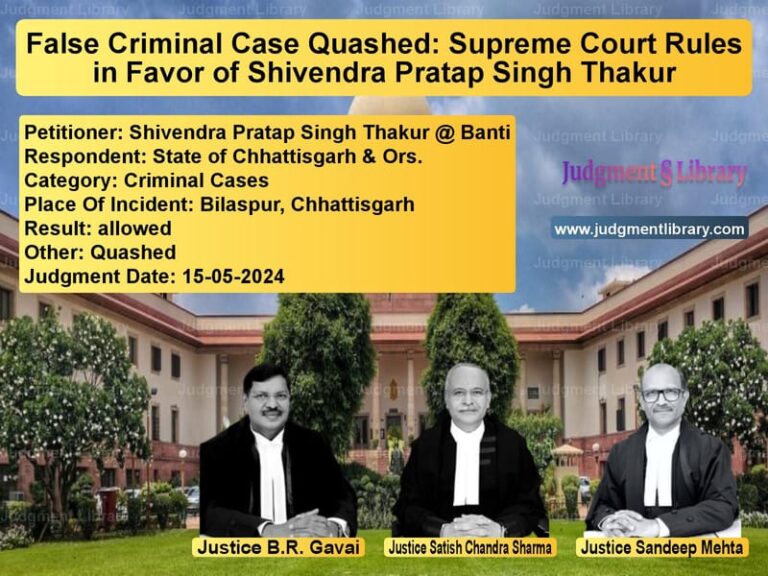Review Petition Dismissed: Analysis of Supreme Court’s Ruling on Legal Services Committee Appointment
The Supreme Court of India recently delivered a ruling on D. Krishna Mohan v. Secretary, Supreme Court Legal Services Committee & Ors., where the petitioner, D. Krishna Mohan, filed a review petition challenging the dismissal of his earlier application regarding the appointment process for the Supreme Court Legal Services Committee. The petition sought the inclusion of certain reforms and transparency measures in the process of selecting members for the Committee, particularly focusing on issues of legal representation and accessibility for the poor and marginalized.
Background of the Case
The petitioner had originally filed a writ petition in 2019, seeking the implementation of more rigorous selection procedures for appointments to the Supreme Court Legal Services Committee. The Legal Services Committee plays a crucial role in providing free legal services to individuals who cannot afford to hire a lawyer. However, the petitioner argued that the current appointment procedure lacked transparency and failed to adequately represent the interests of marginalized groups.
In 2022, the petitioner filed a review petition challenging the dismissal of his earlier petition by the Court. The review petition sought the reconsideration of the legal framework surrounding the appointment and functioning of the Committee, emphasizing the need for structural reforms and enhanced public participation in the process.
Petitioner’s Arguments
The petitioner, represented by his legal team, presented the following arguments in support of his review petition:
- Lack of Transparency: The petitioner argued that the selection process for the Legal Services Committee lacked transparency, particularly with regard to the criteria for appointments. He contended that there was no clear procedure in place for the selection of members or for the disclosure of appointment decisions, which led to a lack of accountability.
- Need for Inclusion of Marginalized Groups: The petitioner emphasized the need for the inclusion of individuals from marginalized communities in the Committee, particularly from rural areas and those from economically disadvantaged backgrounds. He argued that their voices were not adequately represented in the current system.
- Recommendations for Structural Reforms: The petitioner proposed a series of reforms, including the creation of a public platform for nominations to the Committee, along with public hearings for transparency. He also suggested that the appointment process should be more inclusive of non-legal professionals, to ensure a balanced representation of society.
- Reconsideration of Earlier Dismissal: The petitioner argued that the dismissal of his earlier petition was premature and lacked proper consideration of the public interest involved. He sought the Court’s intervention to address these issues and ensure that the Committee operated in a fair and transparent manner.
Respondent’s Arguments
The respondents, represented by the Supreme Court Legal Services Committee, contested the review petition with the following points:
- Compliance with Existing Guidelines: The respondents argued that the current appointment process for the Committee already followed the established guidelines and that there was no need for further changes. They emphasized that the existing process was fair and had been implemented for several years without significant issues.
- Representation of Marginalized Groups: While acknowledging the petitioner’s concerns, the respondents argued that the Committee already ensured the inclusion of marginalized groups in its appointments. They pointed out that there were already provisions for providing free legal services to individuals from disadvantaged sections of society.
- Judicial Independence: The respondents argued that any structural changes to the Committee’s functioning could compromise the judicial independence of the Court and the Committee. They stressed that the appointment process should remain independent of external influences, ensuring that only qualified professionals are appointed to such critical roles.
- No Grounds for Review: The respondents contended that the petitioner had failed to present any new arguments or evidence that warranted the review of the Court’s earlier decision. They maintained that the original dismissal was justified and that there was no reason to reopen the matter.
Supreme Court’s Observations
The Supreme Court, in its deliberations, made the following observations:
- Review of Legal Services Committee’s Functioning: The Court observed that while the Legal Services Committee had made significant progress in providing free legal services, it was important to periodically review its functioning to ensure that it continues to meet the needs of marginalized communities. However, the Court also noted that such reviews should be based on clear legal guidelines and procedures.
- Transparency and Accountability: The Court agreed with the petitioner that transparency and accountability were critical in the functioning of any public body. However, it emphasized that the appointment process must remain within the purview of the judiciary’s independence and that structural reforms should be carefully considered to avoid any unintended consequences.
- Inclusivity of Marginalized Communities: While the Court acknowledged the importance of inclusivity, it noted that the current system had provisions in place to ensure that marginalized groups were represented. The Court emphasized that the Committee’s efforts to provide free legal services to these groups were in line with its mandate.
- No Grounds for Intervention: In its final assessment, the Court stated that while the issues raised by the petitioner were important, there was no immediate need for judicial intervention. The Court found that the existing processes were adequate and that the review petition lacked sufficient grounds to warrant any change.
Supreme Court’s Verdict
The Supreme Court ruled that:
- The review petition was dismissed, as the Court found no sufficient grounds to intervene in the earlier order.
- The Court acknowledged the petitioner’s concerns regarding transparency and inclusivity but emphasized that structural reforms to the Legal Services Committee could not be imposed without a thorough legal review and public discussion.
- The Court concluded that the existing procedures for appointing members to the Legal Services Committee were sufficient and in compliance with the law.
Key Takeaways from the Judgment
- Transparency in Appointments: The judgment underscores the importance of transparency in the appointment process for public bodies, especially when those bodies are responsible for serving marginalized communities.
- Judicial Independence: The Court reaffirmed that judicial independence must be preserved in the functioning of the Legal Services Committee and that any reforms should be carefully considered to avoid compromising that independence.
- Periodic Reviews: The ruling highlights the need for periodic reviews of public institutions to ensure that they remain responsive to societal needs, but it also stresses that these reviews must be grounded in established legal procedures.
- Access to Legal Services: The judgment reaffirms the importance of ensuring access to legal services for marginalized and economically disadvantaged groups, which remains a core objective of the Legal Services Committee.
Implications of the Judgment
The judgment has several important implications for public law and the functioning of legal services:
- It sets a precedent for how courts will approach review petitions regarding public service appointments, emphasizing the importance of adhering to existing procedures and the principle of judicial independence.
- It reinforces the idea that legal services should be accessible to all, particularly those from disadvantaged communities, and that transparency in the functioning of such services is crucial.
- The ruling serves as a reminder that structural reforms to public bodies, particularly those involved in the provision of essential services, must be grounded in legal frameworks and should not be implemented hastily.
Conclusion
The Supreme Court’s decision in D. Krishna Mohan v. Secretary, Supreme Court Legal Services Committee reflects the balance between maintaining judicial independence and ensuring transparency and inclusivity in the legal services sector. While the petition for judicial intervention was dismissed, the Court’s observations provide valuable insights into the ongoing efforts to improve legal access for marginalized groups, reinforcing the importance of procedural integrity and accountability in the appointment processes of public institutions.
Petitioner Name: D. Krishna Mohan.Respondent Name: Secretary, Supreme Court Legal Services Committee & Ors..Judgment By: Justice Uday Umesh Lalit, Justice M.R. Shah, Justice Sanjiv Khanna.Place Of Incident: New Delhi, India.Judgment Date: 01-11-2022.
Don’t miss out on the full details! Download the complete judgment in PDF format below and gain valuable insights instantly!
Download Judgment: d.-krishna-mohan-vs-secretary,-supreme-c-supreme-court-of-india-judgment-dated-01-11-2022.pdf
Directly Download Judgment: Directly download this Judgment
See all petitions in Fundamental Rights
See all petitions in Public Interest Litigation
See all petitions in Separation of Powers
See all petitions in Emergency Provisions
See all petitions in Judgment by Uday Umesh Lalit
See all petitions in Judgment by Mukeshkumar Rasikbhai Shah
See all petitions in Judgment by Sanjiv Khanna
See all petitions in dismissed
See all petitions in supreme court of India judgments November 2022
See all petitions in 2022 judgments
See all posts in Constitutional Cases Category
See all allowed petitions in Constitutional Cases Category
See all Dismissed petitions in Constitutional Cases Category
See all partially allowed petitions in Constitutional Cases Category







